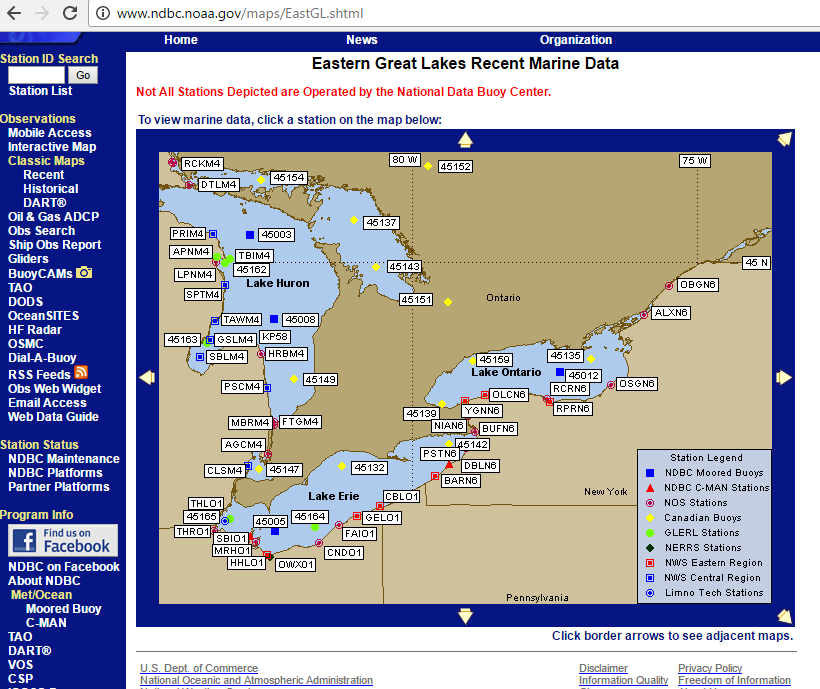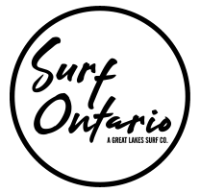
The Buoys Are Back Up and Running - How This Helps Us
The shipping buoys are being re-activated for this season on the Great Lakes and this can save us Lake Surfers time and headaches. (Though sometimes the buoys create headaches when they change for the worse!)
I've been actively monitoring buoy reports for 15 years both before and after surfs and through this, I've gained a good understanding of what the surf conditions will be like based on what the buoy is reading. This took a fair amount of trial and error. Originally I used a marine weather radio that tuned into the local conditions for updates. Now with online reports, we can get get instant updates on our phones wherever we are.
Click here for the Eastern Great Lakes Buoys.
Click here for Western Great Lakes Buoys.
Click on a buoy in the lake near where you're going surfing and you'll get important information both current and past. To keep things simple let's look into:
- Wind speed and direction
- Wave height, period and direction
- Water and air temperature
- Wind Speed and Direction - Wind Creates Waves with Fetch
Strong wind is great but it has to cross water to make waves. Fetch is basically how far the wind has blown over the water. You can even surf on Lake Simcoe though you need considerably less fetch than you might think to have fun out there.
Let's take a look at the Ajax Buoy 45159 in Lake Ontario and how it applies to local Toronto surf spots Woodbine Beach (Abay) and Bluffer's Park (The Cove) on an easterly swell in two difference scenarios:
Scenario #1 Onshore wind that's SE, ESE, E, ENE, or NE at about 10-13 knots across the lake over a few hours will create a small rideable wave at Abay on a SUP or longboard. The buoy will likely read between 1.6 and 2.3 feet in this scenario.
Wind Direction - Notice these spots will work in some capacity in 5 different easterly wind directions depending on the wind speed. (Check random tips at the end for S and SW options) If the east windswell at Abay has more southerly direction in it (ie. the wind and swell is more from the SE or ESE) then the waves are generally messy and less organized.
If the east windswell at Abay has a more northerly direction, the wave tends to be about the same size but better organized as the wave wraps into the bay more AND the local wind conditions are more side shore than straight onshore. The Cove in this scenario will be flat. (There are exceptions as you'll see below)
Scenario #2 Now let's say the wind is blowing SE, ESE, E, ENE, or NE at about 20-25 knots. This will create quite a good swell typically in the 5' to 7' range on the Ajax buoy. In this scenario, Abay beach will be blown out and the waves too big resulting in messy, stormy conditions. However, if you head over to the Cove you'll find the waves breaking nicely in the bay at chest to head high. Again the more northerly direction in the wind, the cleaner the waves will break.
Here's a screen shot of the Ajax buoy from April 25th, 2017. Notice the wind speed and wave size.
- Wave height, period and direction - What you really need to know
Taking the above report into consideration, where would you go? The surf Abay beach tends to work best on a buoy reading of 3' or under. I find once it gets beyond 3.3', it becomes a washing machine and you need to seek out other spots. At 3.6', The Cove may just be starting to break so it's worth a check if you know the waves are building.
How do you know if the waves are building? Check the Easternmost buoys 45135 and 45012. If the east buoys are reading 4' or there's a lot of wind on that side - let's say 20 knots or more and it's been blowing for a few hours - then you know the waves are on the way and will get bigger locally. Tip: Waves usually take about 4 or 5 hours from the east side buoys to hit Ajax.
Wave Direction - The blue buoys are run by the NDBC and they report on Wave Direction. Unfortunately, the Canadian buoys do not. As a general rule, wave direction will be similar to wind direction.
If the waves are coming from the NE, surf spots around Hamilton Beach (The Bridge) will likely be the biggest. They are taking the brunt of the swell full-on because of the way Lake Ontario sits geographically and because of the shore angle at Hamilton Beach.
What is interesting to note is if the swell is from the ESE, the spots around The Bridge in Hamilton will be smaller but often cleaner as the waves wrap and funnel down toward Hamilton. Also typically on those types of setups the local wind is lighter.
Check out the Grimsby buoy report from overnight April 25th - it shows how there is light wind locally but the waves keep funneling down from the east. The waves actually got bigger at 6pm when the wind completely died on the west side.
Here's a photo of Stephen Graham that night in Hamilton.

Wave Interval/Period - This is the amount of time between two wave peaks as they pass a certain point. On the lakes we're at the mercy of short period wind swell - waves that are close together, messier and conditions that can make for a relentless paddle out at some spots. On the bright side, wind swell offers us twice the opportunity to catch waves than our ocean going friends who are likely surfing waves with a much greater wave period.
The average wave period we see on the lakes is about 5 seconds. When it's under 5 seconds the surf is smaller and messy, the waves are just building or it's just plain small. The more time there is between waves, the more power the wave will have, the bigger it will be and the waves should stand up better. Basically the longer the period, the faster the waves travel and the more energy they'll have.
Here's a good example of a surf we had in October 2015. A deep low pressure system was spinning over New York for a couple of days and the wind was blowing hard ENE on the east side of Lake Ontario while the west side remained glassy and calm. (The fetch was essentially the eastern two thirds of the lake) For two days the Ajax buoy was consistently reading 2.6 feet at 7 or 8 seconds.
You're thinking, okay perfect for Abay, a bit small for The Cove. Not quite - because the waves were mainly generated from the east side of the lake and they had time to organize before hitting the GTA beaches - the interval increased and the waves at The Cove those days were solid chest high and pumping! Grant Kennedy got a great picture from that day:

- Water and air temperature.
The wind chill, water and air temperature readings are important for a couple reasons. First, you'll be able to accurately choose how to gear up - the wind chill reading is very important. Second, you'll be able to predict how big the waves will get based on how strong the wind is blowing.
You'll notice the waves are often bigger in the fall than in the spring with the same wind speed and direction. In the fall the lake water is warm in comparison to the air so there's more downward pressure on the water by the wind to create the waves. On a big N or W wind where the air temperature is below (or far below) the water temperature you'll see the buoys jump up very quickly and you be amped to go surfing!
Alternatively in the spring the opposite is true. The colder denser air over the lake creates a barrier as the warmer wind blows over top and the wind won't create much of a wave. This is called doming or Spring Skunk conditions. I've noticed that it generally starts to happen when the air reading on the buoy is about 5 degrees Fahrenheit higher or more than the water temperature.
Random Tips!
- Waves take about 4 or 5 hours from the East side buoys to Ajax.
- Waves take about 45 minutes from Ajax to Toronto.
- Buoys are in the water from roughly April to November.
- Abay & Bluffer's Beach will have a fun longboard wave on a strong to Gale SW wind.
- Local Wind - The buoys report from the open water, however the conditions on land and where we surf can be much different so it's important to note your local weather station's conditions.
- Bluffer's Lighthouse works on a strong to Gale SW wind with about 60 km of Fetch. The photo below is Jeff Green stoked on that short fetch. Photo by Jon Howcroft.

Have fun surfing and watching the buoy reports this season!
Mike Sandusky



